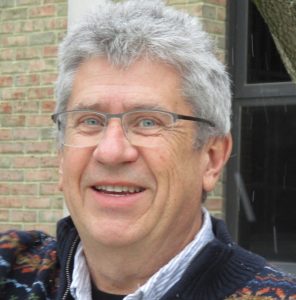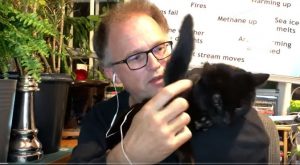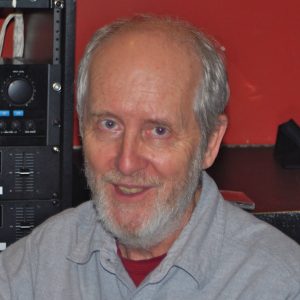When crazy weather goes on and on, we worry “Is this the way it’s going to be now?” Climate scientist Paul Beckwith says there is no new normal. We should expect extremes, swings, and surprises as the world warms. But first meteorologist Richard Rood (University of Michigan) explains the developing bridge between disaster weather and climate change.
Listen to or download this Radio Ecoshock show in CD Quality (57 MB) or Lo-Fi (14 MB)
DISASTER WEATHER AND CLIMATE: RICHARD ROOD
Even as millions of Americans feel beaten up and robbed by storms, many do not know extreme spring weather may be part of the climate crisis. Is that because of scientific caution, or a break-down in critical information? What if even experts can feel shut out?
Welcome to the complex world. Trained in the south, American meteorologist Richard Rood bridges that gap between weather and climate. Richard teaches Masters Level post-grads, while a professor of climate research at the University of Michigan. Dr. Rood is author or co-author of over 100 peer-reviewed papers and the book “Demystifying Climate Models: A Users Guide to Earth System Models” [2016]. That is now available online free – details below.

Dr. Richard Rood
Richard also publishes articles at “The Conversation”. His latest there is about the strange record high water levels in the Great Lakes, after years of low water there. One fifth of the world’s fresh water is in the Great Lakes.
Listen to or download this 30 minute interview with Richard Rood in CD Quality or Lo-Fi
Speaking about the recent extremes in storms and flooding in mid-to-Eastern America, Richard Rood told USA today “...it [is] extraordinarily unlikely that this is just a set of typical weather events, that just happen to occur at the same time…” He concludes climate change has to be involved.
INDIRECT AFFECTS SHOW UP BEFORE DIRECT ONES
Those unexpected results of heating a planet seem to pop up sooner than events with obvious, easy-to-prove climate causes. A recent Ecoshock guest provided another one: even when heat records are not set, back-to-back heat waves are increasing in the instrumental record since the year 2000.
The multitude of tornadoes in the Spring storms hitting the central U.S. was shocking. Patrick March from the National Weather Service Storm Prediction Centers sent out this Tweet:
“We’re currently sitting at 500 filtered *eyewitness tornado reports* during this time period. Only four periods in the official database ever exceed 500 *observed* tornadoes in 30 days: 2003, 2004, 2008, and 2011.”
Since the year 2000, Earth is seeing a new pattern in tornadoes not seen since 1960. A graph in this Fox New story shows the frequency of tornadoes increasing steadily since 1960, with the only years showing over 500 tornadoes in the month of May (the busiest month) are all since the year 2000.
A single tornado may not be record-setting. We may still get several years between such high-numbers. But clustered outbreaks of tornadoes may be another unexpected side-effect of global warming. However, Richard Rood said in this interview that tornadoes are small scale “and the connections to climate would be indirect”. But the shift in the position of Tornado Alley toward the east is likely due to climate change.
THE BRIDGE BETWEEN METEOROLOGY AND CLIMATOLOGY
For a couple of decades, meteorologists and climate scientists barely spoke. There was almost a competition for funding and attention. Now we are seeing the two sciences interact, with climate attribution showing up for particular weather events, and weather skewed by such things as Arctic sea ice melt. Now it’s obvious that climate and weather are part of the same continuum, operating on different time scales. Climate and weather scientists even share some of the same modeling software.
CLIMATE INFORMATICS
We spoke briefly about Richard’s specialty of “climatic informatics”. As Richard knows from his 20 years working with NASA, satellites and the great models are churning out data and reports about the world. Some of that data flow and models attempt to be transparent, offering access to the public. But it still takes an expert to translate that data into the various models and databases used by various sciences. It is possible that cannot be fixed at the national government level. As Rood wisely says in his article “Climate Informatics: Human Experts and the End-to-End System”:
Climate Informatics: Human Experts and the End-to-End System
“There is simply more volatility and complexity in data, technology, and user needs than can be accommodated by a command-and-control approach.”
“Vast quantities of data, better than we ever had before, are swimming behind complex portals with insufficient manuals.” (Sorry I can’t find the source of that quote). In 2016, Richard Rood started on that manual, with his book “Demystifying Climate Models”. The publisher Springer has opened that book in electronic form, which you can download for free here.
The idea of an “End-to-End System” calls up something even bigger. We need to bring the terrible discoveries by scientists about our climate crisis to every person on the planet. One “end” to the information system has to be the simple person. Meanwhile, most of my listeners who want to see real time data about current weather around the world and the big-picture patterns use earth.nullschool.net and climatereanalyzer.org. That’s as close as we get for now.
In the interview, Richard recommends Paul Edwards as historian of weather and climate science. See in particular: Edwards’ book “A Vast Machine: Computer Models, Climate Data, and the Politics of Global Warming” (MIT Press, 2010)
ON THE FAILURE OF TV NETWORKS TO MAKE THE CLIMATE CONNECTION
Regarding failure of TV networks to report climate connection, Richard says:
“one of the political tactics that is going on in the United States right now is to create this sort of distracting chaos that keeps people from looking at what’s going on under the hood“.
He also suspects a certain amount of “climate fatigue” in hearing about climate so much. Richard did an interview a couple of weeks ago with the Wall Street Journal. Rood tells us: “Any time we do an interview that reaches out of the choir that’s interested in climate change, we get harassing emails.” TV meteorologists get feedback from users, and probably from certain advertisers, he says. He doesn’t know, and I don’t know, what directives TV weather presenters get from their bosses or from owners of the network.
We live directly in the weather. Weather is becoming a more scary place because of our changes to the atmosphere – so it’s good to have experts like Richard Rood to help explain why it happens.
==============================================================================================
NO NEW NORMAL! PAUL BECKWITH
Listen to or download this 28 minute interview with Paul Beckwith in CD Quality or Lo-Fi
Climate truth is breaking into the mainstream. Like this headline from USA Today: “End of civilization: climate change apocalypse could start by 2050 if we don’t act”. I’ll be talking with David Spratt, one of the authors of that new report – next week. But this USA Today story is just one blip buried in celebrity news and the Donald Trump show. Still – maybe soon they will hear about Radio Ecoshock and Paul Beckwith.
Paul is a regular correspondent here. He is the Canadian climate scientist who set out to educate the world via You Tube. As recent extreme weather reveals the nasty side of climate change, it’s time to get Paul’s assessment.

Canadian climate scientist Paul Beckwith
HITTING THE CARBON GAS PEDAL
Paul has a little more company now as big papers like the New York Times, USA Today, and the Guardian UK are starting to report on the developing climate disaster. Behind that news, Mark Kaufman at Mashable jolted me with the basics. It’s not just that we are adding billions of tons of greenhouse gases to the atmosphere again this year. We are doing it faster. He writes, quote:
“After the Scripps monitoring station atop Hawaii’s towering Mauna Loa went online in 1959, CO2 rose around just 0.7 [parts per million] ppm per year in the early decades of operation. Then, in the 1990s, the rate increased to 1.5 ppm per year. The last decade has averaged 2.2 ppm. Yet, in the last year [2018], it was a 3.5 ppm gain. Concentrations of the planet’s most influential greenhouse gas are accelerating.”
That is the scariest news of all. We are literally hitting the gas pedal, as we drive toward the cliff. Isn’t that what is behind everything else we talk about?
WHAT WILL THE NEW WEATHER LOOK LIKE?
We can’t talk extreme weather without covering the 45 days of constant storms running from Texas to the northeast. It was floods, hail, tornadoes, the works.
Right off the bat, Paul brings up the tornado problem. That’s partly because a rare tornado hit Ottawa Canada on Sunday June 2. On the same day, there was another even stranger tornado way north in the Northwest Territories, in the Canadian Arctic. Paul told Canada’s national radio network (CBC) that Ottawa’s wild weather was “just the tip of the iceberg”. You can see that Ottawa tornado here on Paul’s busy Facebook page.
Posted by Paul Beckwith on Thursday, June 6, 2019
When we get to any “new normal” is will be, Paul says…
“that region of stability that we are heading to is a much warmer planet, with really bizarre, weak, fractured Jet Streams and much more monsoonal torrential rain patterns on the land – and we’re already seeing it.”
Paul Beckwith really is a pioneer in the science of abrupt climate change. I know he considered doing a PhD Thesis just on that, but got swept away by the torrent of evidence it is already here. We talk about Paul’s new six-part video series on abrupt climate change (links below). I have been stewing about the inevitable clash between climate-driven weather extremes and our need for more and more human food on this planet. That’s in one of the videos of this series.
THE BIG HEAT
Then we have the inevitable pressure of longer and harsher heat waves building in future years. It is not that far in the future. Just last week Northern India just went over 50 degrees Centigrade, or 122 degrees Fahrenheit. They poured water on the roads trying to keep them from melting. Farm animals and people keeled over dead. That means 1.37 billion people suffering in extreme heat! Hardly anyone in Europe or North America even heard about it. So the big heat is not far off.
We just had a string of scientists on Radio Ecoshock saying we should expect back-to-back heat waves, and expect hot spells earlier and later in the year. Last week, The Guardian newspaper and the New York Times also covered new science about thousands of heat deaths expected in cities like New York and Los Angeles by 2050, if the climate heats up by 3 degrees C. That seems unreal. I’ll talk with the lead author of that study in next week’s show.
Paul mentions new products to cool bodies. He says MIT is working on what Paul calls “a chill suit” to cool the body directly, rather than air conditioning a whole room or building. I cringe thinking little kids won’t be able to go outside for 100 days a year without putting on technical gear to make the outdoors survivable.
Paul and I also discuss the new article on high waters in the Great Lakes, just published by our first guest Richard Rood. Paul has great details on why this caught everyone by surprise.
MORE ON THE FAILURE TO COMMUNICATE BY MAJOR MEDIA
Here in North America there has been so much extreme weather coverage, with such great videos from people’s phones. It is hard to look away. People are calling it “weather porn”. It is thrilling and entertaining to see those floods, fires, and big twisters – until your own home is taken away. Maybe we are going to get out the popcorn and watch the climate apocalypse on our big screen TVs, without bothering to vote out the climate deniers, or hit the hot streets to protest anything. I hope not, but that is how it’s shaping up so far.
The weird thing is the big TV networks get lots of eyeballs for climate-driven disasters, and then they sell your attention to car and energy companies to burn more carbon, or ads to pharmaceutical firms to drug us comfortably numb. We are caught in a kind of cross-fire of duel strangeness. But only one reality triumphs in the end, and that is physics and climate science.
In his You tube videos, Paul takes you through every step to understand the latest climate science and current extreme weather. Be sure to visit his fabulous You tube channel, his web site at paulbeckwith.net, and his busy Facebook page. Paul has no big institutional funding, so be sure to hit that button to support his work.
Among Paul’s new videos to check out:
“Humanities Tombstone Inscription: Acted Slower Than Expected as Climate Changed Faster Than Expected” plus more in that 6 part series, including “Food, Glorious Food. Never Before Has Earth Needed More” May 30, 2019 (the food crisis); “Earth Life Support Systems Undergoing Wrenching Climate Change Paroxysms” May 26, 2019, and this blog post “The End Is Near: Paroxysms, Smorgasbords, Earth Life Support”, May 26, 2019.
The End Is Near: Paroxysms, Smorgasbords, Earth Life Support
—————————-
Thank you for sticking with Radio Ecoshock. I know the rolling truth about climate and our broader environment can be seem hopeless at times. We all hope that eventually scientific truth and developing harsh realities will drive our neighbors, countries and our species toward survival instead of mass suicide. With that cheerful thought, thank you for listening, for supporting me financially to make this program, and for caring about our world.

Alex
Alex,
Regarding the accelerating CO2 levels in the atmosphere, year over year, do you know if this is caused by increased emissions by humans or decreasing effectiveness of CO2 sinks (such as the oceans) or additional sources of CO2 from melting permafrost or tropical forests or some combination of these? I’m just wondering if you’ve come across somebody who could shed some light on this.
Thx…love the show.
My understanding is the increase RATE of CO2 emissions comes mainly from burning fossil fuels. The CO2 level does not include methane, which is also increasing in the atmosphere. Excess methane is coming from natural gas production and transportation (leaky pipelines, fracking) – and from tropical peat bogs especially in East Africa. We had a guest on explaining that. There are too many ways that humans add CO2 to list out, including carbon lost from agricultural operations, releases from crop drying, cutting down sinks like the Amazon, etc. But simple coal, gas and oil burning remain the major source so far – but you ask a good question. I’m sure the definitive answer is out there, but I don’t have the straight facts on it.
Pingback: THERE IS NO NEW NORMAL – CLIMATE CHANGE – NUTECH 2000
Pingback: Negligible consideration is given to rationing and moratoria even though these options could substantially cut emissions immediately without requiring new technologies | Rapid Shift
Pingback: Disaster weather w/meteorologist Dr Richard Rood—Climate change & extremes—Radio Ecoshock 2019-06-12 – NetzeroBullet.in